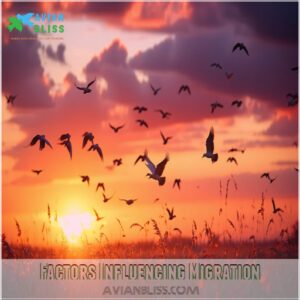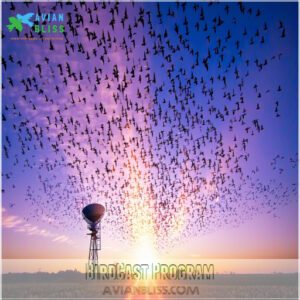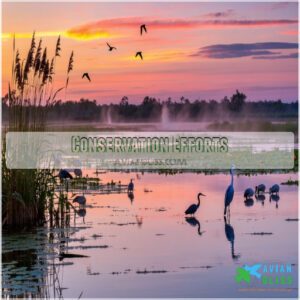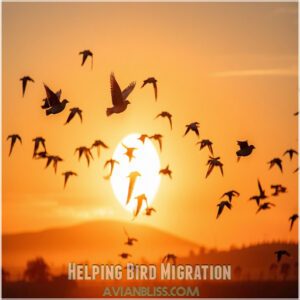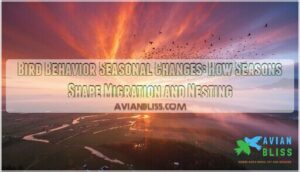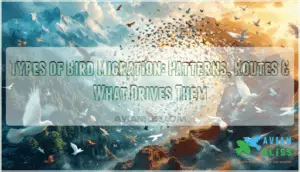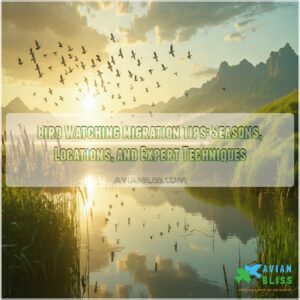This site is supported by our readers. We may earn a commission, at no cost to you, if you purchase through links.
 You’ll find that understanding bird seasonal movements is like following nature’s most incredible GPS system.
You’ll find that understanding bird seasonal movements is like following nature’s most incredible GPS system.
Birds navigate between breeding and non-breeding grounds using an impressive toolkit: stars, Earth’s magnetic field, landmarks, and even their sense of smell.
These seasonal journeys aren’t random wanderlust – they’re driven by survival instincts, changing weather patterns, and the search for food.
Some birds trek across continents, while others simply head up or down mountains.
Each species has its own migration story, from the predictable annual voyages to the occasional resource-chasing adventures.
The ways birds navigate these complex journeys reveal remarkable adaptations that have evolved over millennia, showcasing their ability to use the Earth’s magnetic field in their navigation.
Table Of Contents
- Key Takeaways
- Bird Migration Basics
- Migration Navigation Methods
- Factors Influencing Migration
- Studying Bird Migration
- Helping Bird Migration
- Frequently Asked Questions (FAQs)
- How do birds adapt to seasonal changes?
- How does bird behavior change each season?
- Why is bird migration so complex?
- What is the most common form of bird movement?
- What are bird migration patterns?
- Why do birds migrate in the fall?
- When birds move seasonally What is it called?
- How do birds respond to seasonal changes?
- What seasons are birds most active?
- What are the movements of birds?
- Conclusion
Key Takeaways
- You’ll find birds use an impressive navigation toolkit including stars, Earth’s magnetic field, landmarks, and smell to guide their seasonal movements between breeding and non-breeding grounds.
- You can observe different types of migration patterns – from birds crossing continents (latitudinal), moving up mountains (altitudinal), to partial migration where only some populations relocate based on food availability and weather.
- You’ll see how biological factors drive migration timing, as birds respond to environmental triggers like changing daylight hours and temperature shifts while relying on hormonal changes and genetic programming to prepare their bodies for long journeys.
- You can help migrating birds by creating bird-friendly yards with native plants and feeders, reducing light pollution at night, and supporting conservation programs that protect critical habitats along migration routes.
Bird Migration Basics
Bird migration is the seasonal movement of birds between breeding and non-breeding grounds, driven by the search for food, favorable climates, and nesting sites.
By understanding these journeys, you can uncover patterns that reveal how millions of birds navigate vast distances with precision.
What is Bird Migration?
Bird migration is a natural phenomenon where bird species travel vast distances using specific flight routes.
These seasonal movements guarantee access to food, safety, and suitable breeding grounds. Avian behavior shifts with changing temperatures and daylight, creating migration patterns unique to each species.
Through these well-timed journeys, migratory bird species adapt to their environments, embodying nature’s rhythm and resilience.
Why Do Birds Migrate?
Why do birds pack up and leave? It’s all about survival instincts.
Migratory bird species follow bird migration patterns to chase food sources, escape harsh weather changes, and find ideal breeding patterns.
These avian seasonal habits align with migration ecology, ensuring resources along migration routes.
By adapting bird seasonal behaviors, they outsmart nature’s challenges and keep thriving.
Understanding habitat conservation strategies is paramount for protecting these species during their migrations, which involves considering harsh weather changes.
Types of Bird Migration
Migration takes many forms, showcasing the adaptability of birds.
Some species venture great distances through latitudinal migration, crossing continents for warmer habitats. Others shift altitudes, a movement known as altitudinal migration, to find safer nesting areas.
In partial migration, only part of a population relocates. Occasionally, irruptive migration occurs, driven by sudden environmental changes.
- Latitudinal migration spans global routes.
- Altitudinal migration focuses on elevation shifts.
- Partial migration involves selective movement.
- Nomadic movement responds to food availability.
Migration Navigation Methods
You’ve probably wondered how birds find their way across thousands of miles during migration.
From using the stars to sensing Earth’s magnetic field, birds rely on fascinating natural tools to navigate with precision.
Celestial Navigation
Celestial navigation is like using a cosmic map. Birds align with star positioning and solar navigation cues, compensating for the sun’s movement with an internal clock.
Nocturnal migrants rely on astral mapping to stay on track. Photoperiodism works as a trigger, syncing their timing.
These natural navigation tools, combined with magnetic fields, help them journey confidently and safely. The birds’ ability to detect magnetic field changes is essential for their migration patterns.
Geomagnetic Cues
Imagine a built-in GPS powered by Earth itself—geomagnetic navigation lets birds orient during migration using magnetic fields.
Quantum effects involving radical pairs in their eyes help them detect geomagnetic cues. It’s like nature’s compass, providing navigational accuracy.
- Birds detect magnetic field intensity and polarity.
- Responsive to novel magnetic conditions.
- Geomagnetic cues guide challenging routes.
- Avoids relying solely on daylight or stars.
- Provides precise, long-distance orientation.
Understanding bird migration patterns involves studying migratory bird conservation efforts.
Landmarks and Visual Cues
Orientation skills play a role in bird navigation as species rely on visual cues like topographic features.
Landmark recognition, such as rivers or mountains, aids spatial memory during migration.
Birds often "map" their migratory routes using consistent visual navigation strategies, think of it as their natural GPS—proven effective across bird migration patterns for keeping them on course with effective strategies.
Olfactory Cues
Relying on olfactory cues, many birds use scent recognition to enhance migration accuracy.
Smell navigation helps track aromatic cues like plant odors or sea breezes tied to their migration ecology strategies.
Fragrance detection even aids bird species tracking during seasonal bird movements.
By tapping into olfactory signals, birds cleverly navigate complex terrain, proving their noses are as sharp as their instincts.
Factors Influencing Migration
You’ll find that bird migration is influenced by a mix of environmental triggers, biological factors, food availability, and predation pressure.
These elements work together to push birds toward the survival strategies that best suit their needs throughout the seasons, which is influenced by biological factors.
Environmental Triggers
Weather patterns and environmental cues act like nature’s alarm clocks for birds.
Factors such as temperature shifts and food scarcities signal migration.
Photoperiodism, or changing daylight hours, syncs with birds’ biological rhythms, influencing their movement.
- Rising temperatures disrupt migration timing.
- Habitat loss reduces resting or feeding spots.
- Climate change effects alter food availability.
- Seasonal storms reshape migratory routes.
The factors influencing bird migration are complex and interconnected, with environmental cues playing a crucial role in their movement.
Biological Factors
Biological factors like photoperiodism, hormonal changes, and genetic programming often drive bird migration.
Hormones prepare birds by boosting fat reserves for energy expenditure during long flights.
Physiological adaptations, such as efficient lungs and muscles, optimize endurance, and birds’ internal biological rhythms help time migrations precisely, aligning with environmental cues.
These traits guarantee the journey is efficient and ultimately successful, season after season, thanks to efficient lungs and genetic programming.
Food Availability
As you explore bird migration, note that food availability greatly influences their seasonal movements.
- Seed consumption
- Fruit sources
- Insect prey
- Nut storage impact bird population shifts and migration patterns, driving them to seek ideal habitats with adequate water availability.
Predation Pressure
As you explore bird migration, consider predation pressure, a key factor influencing their movements.
Predator avoidance strategies, such as flock protection, drive bird population shifts, with wildlife conservation efforts aiming to maintain habitat security.
Mitigating climate change effects on natural predators and prey behavior, affecting survival tactics, is crucial for conservation.
Understanding bird migration patterns, including sparrow migration, is important for developing effective conservation strategies.
Studying Bird Migration
You’ll discover how scientists track migrating birds using modern tools like satellite devices and radar systems that create real-time maps of bird movements.
With programs like BirdCast, you can now predict busy migration nights and understand how these incredible travelers respond to our changing climate.
Research Methods
Scientists have revolutionized our understanding of bird migration patterns through innovative research methods.
You’ll find ornithology research has come a long way from simple observation to high-tech analysis.
Here are the primary ways researchers track our feathered friends:
- Bird banding with unique identifying tags
- Lightweight geolocator devices
- Advanced telemetry tracking systems
- Migration modeling using complex algorithms
- Data analysis of movement ecology strategies
These techniques help paint a complete picture of how birds navigate their seasonal journeys. The use of these methods has significantly advanced our knowledge of ornithology research.
Satellite Tracking
Modern satellite tracking has revolutionized our understanding of bird movement analysis.
By fitting birds with solar-powered transmitters, researchers can now map precise migration routes and flight patterns in real-time.
You’ll find it fascinating how these tiny devices reveal individual variations in migratory behavior, even among birds from the same breeding grounds.
The technology has proven particularly valuable for studying birds in challenging environments, like Hawaiian honeycreepers in rugged tropical terrain.
Researchers rely on advanced bird tracking tools to gather accurate data on bird movements.
BirdCast Program
Radar technology takes flight monitoring to new heights through the innovative BirdCast program, which creates real-time mapping of nocturnal bird migration patterns.
You’ll find this remarkable conservation tool tracking thousands of birds as they navigate their seasonal journeys.
Using advanced bird movement analysis, BirdCast predicts peak migration nights, helping researchers understand flight routes and protect these magnificent travelers during their most vulnerable moments.
Conservation Efforts
While BirdCast tracks migrations in real-time, conservation efforts focus on turning this knowledge into action.
You’ll find wildlife conservation teams working tirelessly to protect and restore bird populations through habitat preservation initiatives.
These projects include monitoring bird movements, creating bird-friendly environments, and supporting ecosystem restoration programs.
Bird conservation success depends on reducing human impacts and maintaining biodiversity management strategies that preserve critical stopover sites.
Helping Bird Migration
You’ll discover practical ways to support migrating birds through simple actions like creating bird-friendly yards and reducing light pollution at night.
Your efforts to preserve habitats and participate in conservation programs can make a significant difference in helping these remarkable travelers complete their seasonal journeys, which is a remarkable feat.
Creating Bird-Friendly Yards
While researchers track migrations from above, you can support birds right from your backyard.
Transform your yard into a bird-friendly habitat by planting native species that provide natural food and shelter.
Adding quality bird feeders supplements natural food sources.
Add strategically placed bird feeders, nesting boxes, and birdbaths to create a welcoming stopover site.
Smart yard layout choices, like clustering plants and varying heights, will keep your feathered visitors coming back for more, making your yard a natural haven with strategically placed elements.
Conserving Habitats
Beyond creating backyard havens, safeguarding larger ecosystems safeguards birds’ survival during migration.
The U.S. has established impressive conservation networks through international partnerships.
Here’s how these initiatives safeguard our feathered friends:
- The North American Waterfowl Management Plan restores wetland habitats through public-private partnerships
- WHSRN safeguards over 20 million acres across 7 nations
- Important Bird Areas Program maintains 500+ protected sites
- International conventions with Canada, Mexico, Japan, and Russia help protect habitat preservation
Effective conservation requires understanding habitat conservation strategies to protect migratory birds.
Reducing Human Impact
While protecting natural habitats forms the foundation, you can take direct action to minimize human interference with bird migration.
You can purchase bird safe window decals to prevent collisions.
Turn off unnecessary outdoor lights during peak migration seasons to reduce light pollution.
Create bird-friendly spaces by using window decals and native plants.
Small changes in your daily routines, like proper waste management and sustainable practices, help maintain safe passages for our feathered friends.
Supporting Conservation Programs
Through active participation in conservation programs, you’ll make a lasting impact on bird migration.
Join local wildlife protection initiatives that focus on habitat preservation and sustainable practices.
Your financial support helps fund critical research and eco-friendly management strategies.
Consider donating to organizations like the Southern Wings Program, which coordinates international conservation efforts and guarantees bird populations thrive across their migration routes.
Frequently Asked Questions (FAQs)
How do birds adapt to seasonal changes?
You’d think birds just wing it through seasons, but they’re clever adapters.
They’ll migrate to warmer areas, change their feathers, build up fat reserves, and adjust their diets for whatever Mother Nature throws at them, which makes them clever adapters.
How does bird behavior change each season?
You’ll notice birds’ behaviors shift dramatically through seasons.
They’ll migrate in spring and fall, build nests and breed in summer, while forming winter flocks to share food sources and stay warm.
Why is bird migration so complex?
You’ll find bird migration involves multiple factors: navigation using Earth’s magnetic field, celestial cues, and landmarks.
Plus the timing of seasonal changes, food availability, and breeding needs all working together in nature’s dance, with multiple factors contributing to this complex process.
What is the most common form of bird movement?
Over 40% of North American birds exhibit partial migration, where some populations migrate while others stay put.
You’ll notice this mixed movement pattern most commonly, as it helps birds adapt to varying environmental conditions, exhibiting a behavior that can be described as adapt to these changes.
What are bird migration patterns?
Birds’ migration patterns include latitudinal and altitudinal movements.
You’ll find them flying north-south for breeding, or up-down mountains for resources.
They’ll follow specific flyways guided by celestial cues and Earth’s magnetic field.
Why do birds migrate in the fall?
You’ll see your feathered friends heading south when temperatures drop and food becomes scarce.
They’re following natural instincts to find warmer climates where they’ll have better access to food during winter months.
When birds move seasonally What is it called?
Well butter my biscuit, you’re asking about migration.
When birds hop between locations with changing seasons, it’s called seasonal migration.
You’ll notice they’re following nature’s GPS to find better weather and food.
How do birds respond to seasonal changes?
During cold months, you’ll notice wildlife’s remarkable journey as they migrate to warmer regions.
While others adapt by changing their diets and behaviors, they’ll store food, grow thicker feathers, and form social groups, which is a remarkable journey.
What seasons are birds most active?
You’ll notice peak bird activity during spring and summer when they’re breeding and feeding young.
They’re also quite active in fall during migration, though winter brings reduced activity except at feeders.
What are the movements of birds?
Birds’ll move in different ways: they’ll migrate long distances between breeding grounds, shift to higher altitudes for resources, or make short trips for food.
You’ll spot some staying put year-round too.
Conclusion
As the old saying goes, "Nature’s wisdom flows through birds’ wings."
You’ll discover that understanding bird seasonal movements reveals nature’s intricate design. These remarkable creatures navigate vast distances using tools that scientists are still decoding.
Whether you’re tracking migrating flocks or creating bird-friendly spaces, you’re part of their incredible journey. By protecting their pathways and habitats, you’re helping guarantee these magnificent seasonal travelers continue their ancient patterns for generations to come, which is a testament to their ancient patterns.
- https://www.allaboutbirds.org/news/the-basics-how-why-and-where-of-bird-migration/
- https://www.scientificamerican.com/article/how-migrating-birds-use-quantum-effects-to-navigate/
- https://www.fws.gov/program/migratory-birds
- https://movementecologyjournal.biomedcentral.com/articles/10.1186/s40462-021-00275-5
- https://en.wikipedia.org/wiki/Bird_migration_perils






